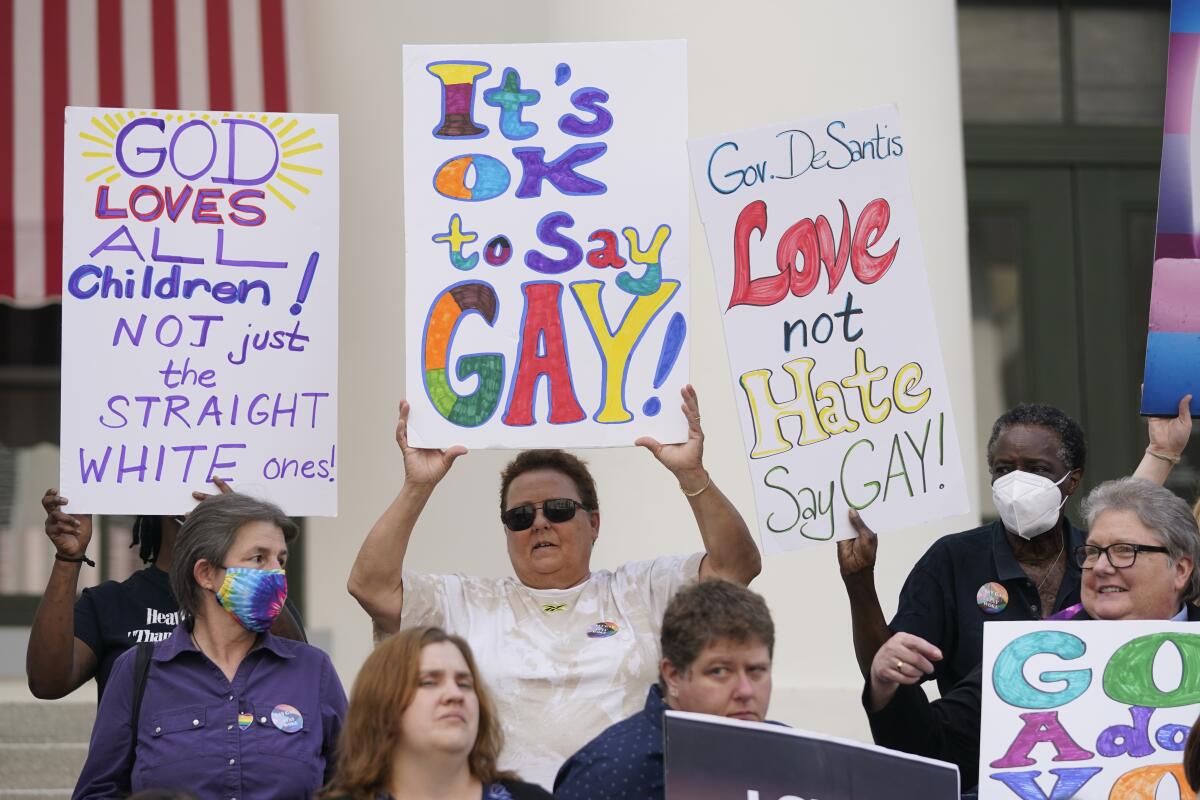Op-Ed: How to disagree about sexism and racism without being a jerk

We once hosted an event at our law school to discuss how members of advantaged social groups could be “allies” to marginalized people. As we left, a white male student ran up to us. He had a burning question he wanted to pose privately: “What if I say something, and a woman says it was sexist, but I don’t think it was. Am I allowed to disagree?”
Our response was easy: “Of course!” But he was right to feel nervous.
As scholars working on diversity and inclusion, we teachmembers of dominant groups how to have better conversations about identity issues. Many advantaged individuals find such disagreements agonizing. They often feel pressure to fake their opinions or defer to their conversation partners, fearing that to express any disagreement is to betray marginalized people or risk getting canceled.
To be clear, we don’t want people to jump reflexively to disagreement. We first advise individuals to build resilience — the ability to manage discomfort — and then cultivate curiosity about others. In that particular student’s case, perhaps his comment was sexist, but he won’t understand why unless he grounds his emotions and listens generously to his conversation partner.
In some situations, however, resilience and curiosity aren’t enough to resolve a genuine difference of opinion. Friends might legitimately disagree over whether it’s appropriate for an organization to fire someone for transphobic comments made a decade ago.
Colleagues might reasonably disagree over whether someone was overlooked for a promotion because of bias. Without space to share disagreements, people will compromise their own dignity and authenticity rather than connecting and growing together. Many potential allies will simply avoid identity-related conversations if they think their only option is to capitulate to whatever the other person says.
The key is to learn how to express such disagreements without causing unnecessary harm to yourself or others.
A critical element is to recognize that not all identity disagreements are created equal. Imagine what we call the “controversy scale,” which plots subjects of disagreement along a straight line. On the left are the safest subjects, where disagreement is expected or even celebrated. On the right are the most controversial subjects, where the conversation is most likely to turn ugly.
Disagreements over personal tastes are usually warm and good-natured, such as when friends mock us for our love of trashy TV shows. Disagreeing over facts is also relatively comfortable, provided it really is a debate about facts (such as who, what, when, where) rather than a thinly veiled debate over values (such as the vitriolic debates over “alternative facts” or “fake news”).
The real danger comes when the topic drifts farther to the right on the controversy scale. The most intense conversations are those in which one or both sides feel their equal humanity has been put into question.
People from more advantaged social groups and less advantaged ones almost always locate relevant issues at different positions on the controversy scale. Take the recent comments of pop star Gwen Stefani when she was asked about accusations of cultural appropriation surrounding her Harajuku Lovers fragrance collection, which draws heavily on Japanese youth culture.
To Stefani, a white woman, the dispute was a policy debate over cultural sharing. She told a journalist that it “should be OK to be inspired by other cultures because if we’re not allowed then that’s dividing people, right?” To the interviewer, however, this topic had much deeper significance: “I am an Asian woman living in America, which comes with sobering realities during a time of heightened Asian American and Pacific Islander hate.” What might seem like a conceptual argument about the definition of cultural appropriation was also a debate over which groups in society have power and which groups are less valued.
Many people fail to take the imaginative leap of considering how their own position on the controversy scale might differ from others’.
Another recent example is that of Gianni Infantino, the president of FIFA, soccer’s governing body, who made headlines for a rambling defense of World Cup host Qatar’s human rights record regarding women, LGBTQ+ people and migrant workers. Rather than emphasizing what the debate might mean to members of these marginalized groups — and how that meaning might differ from his own perspective — Infantino appeared to think his perception of the controversy level was essentially the same as that of his critics.
“Today I feel gay. Today I feel disabled. Today I feel [like] a migrant worker,” he said, adding that he knows “what it means” to be discriminated against: “As a child at school I was bullied because I had red hair and freckles.” Infantino could have opened a nuanced, empathetic debate about how best to advance human rights in hostile jurisdictions. Instead, the conversation turned into a train wreck.
To use the controversy scale in a conversation, start by identifying where you would place a particular disagreement on the scale, then consider how your conversation partner might place it differently.
Suppose you are a parent of a white child, discussing the local school’s anti-racist curriculum with a parent of a Black child. You might see the dispute as a factual debate over specific events in American history, or as a policy debate over how such history should be taught at different grade levels. They might see it as a debate over whether their child belongs at the school. To that parent, the antiracist curriculum might feel immediate and emotionally charged, while to you it feels more abstract and distant.
You may find that when you empathize with the other person’s situation, you’ll reassess the nature of the disagreement, and your perception of the issue will move closer to where they’ve placed it on the scale. But you might not.
The mental exercise can still pay off if you explicitly acknowledge how your counterpart’s position might differ from your own: “To me this is a policy debate, but I see how it could be deeply personal for you, and I’ll do my best to respect that fact when sharing my views.”
There might also be times during or after a conversation when you realize you treated the topic as a purely intellectual exercise and need to recognize the impact the discussion might have had on the other person: “I’ve been bringing policy arguments to the table, but can I ask how you’ve been experiencing this discussion as someone whose life may be more directly affected by this issue?” Routinely, allies fail to take these simple but critical steps, depriving identity conversations of the empathy and respect they sorely need.
Using the controversy scale is one way to keep important conversations going. The worst outcome would be for people who see the world differently to disengage and learn nothing from each other.
When handled well, sharing a thoughtful difference of opinion can show the other person you value them enough to be honest with them. Learning to disagree respectfully is a gift you give yourself, but it’s also one you give to your conversation partner.
Kenji Yoshino and David Glasgow are the faculty director and executive director, respectively, of the Meltzer Center for Diversity, Inclusion and Belonging at the New York University School of Law. They are co-authors of the forthcoming book “Say the Right Thing: How to Talk About Identity, Diversity, and Justice.”
More to Read
A cure for the common opinion
Get thought-provoking perspectives with our weekly newsletter.
You may occasionally receive promotional content from the Los Angeles Times.










